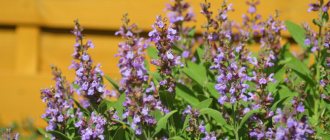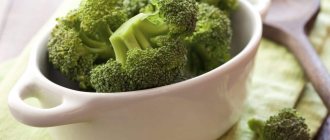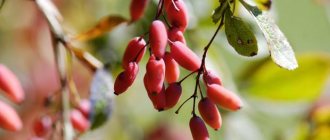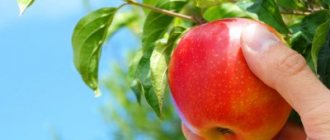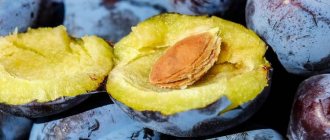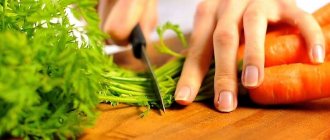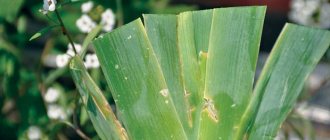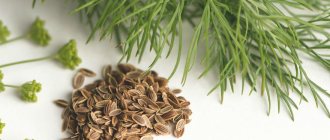How to Harvest Sage
Sage is a perennial herb whose full growing season lasts two years. Therefore, a full harvest of sage begins in the second year of the plant’s life. In the year the crop is sown, the first harvest can only be harvested in the fall. In all subsequent years, grass is harvested in two stages: in summer (late June - July) and autumn (September - early October).
Leaves and tops of shoots are used for medicinal purposes, since it is in these parts of the plant that the maximum amount of beneficial substances and esters is concentrated. In the first two years, only the lower leaves are collected from the bush, and later the raw materials are collected from the entire above-ground part. At the same time, you can collect leaves either with your hands or with the help of scissors, pruning shears, or a sickle - sage grows quickly, and when cut at the base in the summer, it again forms a young bush by autumn.
It is advisable to collect sage on warm sunny days when the plant is dry. Dirty, dusty grass should first be washed with water from a watering can or hose, and then wait until the plants are completely dry. When collecting raw materials for medicine, you need to ensure that diseased or insect-damaged shoots do not get into the total mass.
How to properly collect material
Only at first glance it may seem that collecting medicinal herbs is an ordinary event. In reality, this procedure requires certain skills and knowledge. Since the collected plant material must subsequently undergo long-term drying, for maximum convenience of this process, healers advise selecting branches with a fully blossomed lower part and buds at the top. In this case, you can collect sage in two ways:
- completely tear off the stem with foliage and inflorescences;
- cut off the necessary parts of the bush with pruners or scissors.
In order not to damage the plant, you need to cut off not all elements suitable for drying, but only part of them. Such careful attitude will enable the bush to bloom safely next year, which will provide a new harvest of useful raw materials.
In summer time
Summer sage harvesting takes place in early summer (late June), when the inflorescences begin to bloom. The grass harvested during this period is more saturated with esters, and therefore is of particular value for traditional medicine, as well as for cooking - dry plants are considered a spice, and are successfully used as an additive to many dishes.
For drying, you should choose intact shoots with dark green foliage, as well as buds that have not fully blossomed. Summer grass harvesting lasts approximately 20 days, until mid-July. Then the sage fades, and seeds begin to ripen in place of the inflorescences. During this period, the green part of the plant becomes coarser, and the concentration of useful components decreases, so it is not advisable to collect the grass. The crop reproduces well by self-sowing - dry seeds that fall into the soil germinate after the first rain.
Sage (lat. Salvia)
Salvia officinalis is a subshrub belonging to the Lamiaceae family, with numerous tetrahedral stems, densely leafed, 70 cm high. The leaves are gray-green in color, the flowers are bluish-violet.
The plant has a pleasant aroma. Can be found in Crimea and some parts of the Caucasus as well as in the southern part of Russia.
The plant is collected and prepared in June and September. It is during these months that sage has a denser composition of substances and minerals.
The leaves are used for medicinal purposes.
Collection. Sage is harvested 2 - 3 times. In June, when the leaves are just beginning to grow younger and at the end of flowering in September. Only sage leaves are collected, which contain essential oils, tanning agents and alkaloids.
Used as a flavoring agent in the fish canning and alcoholic beverage industries.
Sage grows in mountainous and warm areas. Requires good soil moisture, but does not tolerate its excess. Sage is poorly resistant to cold.
Propagated by seeds. In the first year it grows slowly, forming shoots. The second year of vegetation, shoots form. Over time, the shoots become woody and remain for several years. When the shoots are removed (in a timely manner), young leaves are formed and large leaves develop.
You should not be late in harvesting leaves. By October, the essential oil content decreases significantly.
Active substances: alkaloids, flavonoids, resinous substances, tannins, acids, vitamin P, bitterness, vitamin PP. phytoncides, cineole, pinene, thujone, borneol, thujol, salvain, B vitamins and camphor.
Botanical description
The stem is straight, gray-green, branched, all pubescent. The bottom of the stem is covered with brown bark.
The leaves are numerous, oblong, 5-8 cm, the leaves are dark green above, grayish-light below, with hairs.
The inflorescences are simple and branched. The flowers are large, located in the axils of the bracts, on short pedicels, with opposite whorls.
The fruit is four single-seeded nuts. The seeds are ovoid, dark brown in color, smooth. The seed size is up to 3.0 mm, the weight of 1000 seeds is 8 g.
When rubbed, a strong aromatic, spicy odor is felt,
Seeds can remain in the ground for three years, after which they can sprout.
Useful and healing properties of sage
In medicine, an infusion of leaves is used as a rinse for the mouth, pharynx, and larynx.
Sage leaves help reduce sweat secretions.
Promotes the release of secretions in the gastrointestinal tract; is an anti-inflammatory agent.
Helps with diseases: oropharynx, upper respiratory tract, nasopharynx, gastritis, skin, frostbite, inflammation of the bladder, stomach ulcers, festering ulcers, burns, wounds, diseases of the duodenum.
Sage preparations are used taking into account the anti-inflammatory, astringent, phytocide and disinfectant properties of this plant. Infusions of leaves are used for rinsing, lotions and inhalations.
For medicinal purposes, bandages and napkins soaked in infusion are used, local or general baths are prescribed with the addition of sage infusion.
Sage infusions are prescribed for inflammation and pain in the bladder.
The fact that sage preparations suppress lactation in nursing mothers is not a good sign. This ability needs to be directly studied.
Dangerous and harmful properties of sage
Do not use sage in high doses or for longer than 3 months - it causes irritation of the mucous membrane.
It is not recommended to use for epilepsy, severe cough, kidney inflammation, acute nephritis.
Do not take during pregnancy or breastfeeding!
Harvesting in autumn
The second harvest of sage grass lasts from late September to mid-October, when the plants have fully recovered from the hot summer. By autumn, self-seeding bushes will form and strengthen, and on bushes cut in summer, velvety greenery will grow again and buds will appear. The concentration of nutrients in autumn grass is in no way inferior to that collected in summer, so the autumn harvest is no less valuable.
In autumn, sage is also harvested on dry days. If the weather is often rainy, you need to wait until the plants are completely dry and only then collect. Bushes growing within the city, especially along roads, should not be used for drying - such plants are saturated with industrial emissions and exhaust gases. For use as food and medicine, it is important that the herb is of high quality and correctly collected.
Useful properties of sage
The rich composition of a medicinal plant is one of the best examples of a formula created by nature itself for the interaction of various substances. This set contains:
- vitamins in all the diversity of representatives of this group;
- many mineral salts necessary for the full course of biochemical processes;
- there are essential components and tannins;
- organic acids are present, as well as bitterness with resins.
All these ingredients in a single alliance have a beneficial effect on human health. Moreover, it is not necessary to use a herbal preparation when obvious signs of the disease appear. Medicinal sage is considered a universal preventive remedy for a number of diseases. The list of its main properties:
- antiseptic;
- anti-inflammatory;
- astringent;
- choleretic;
- expectorant;
- diuretic;
- antispasmodic;
- hemostatic;
- calming.
Sage is part of herbal preparations that are used in home therapy for such common diseases as bronchitis, sore throat, hemorrhoids, and digestive disorders. The healing herb helps to cope with inflammatory processes of the genitourinary tract in men and women. The plant is used to treat burns, open wounds and pustular diseases on the skin. Of course, such an impressive list of worthy qualities arouses interest. Therefore, many rational people try to independently prepare such valuable raw materials.
Both wild and ornamental types of sage are suitable for medicinal needs.
How to store sage
For long-term storage of sage, drying is necessary. Properly collected and well-dried herbs can be stored for up to 2 years if the following conditions are met:
- the container for storing dry leaves must be breathable (made from natural materials: cardboard, parchment, cotton) - storage in tightly closed glass or metal jars is allowed, but no more than a year;
- the place or room for storing harvested grass should be dry, well ventilated and preferably dark;
- Dried sage should not be stored in bunches, as the herb quickly burns out and loses its beneficial and tasteful qualities - it is better to separate the leaves and inflorescences from the dried shoots, and then place them in containers intended for storage;
- it is necessary to regularly check the quality of dry raw materials, since very often various pests appear in the grass: food moths, mold;
- It is better to store dry raw materials separately from other herbs and products, because the strong sage aroma tends to quickly evaporate, mix and be absorbed.
It should also be taken into account that in bags, boxes, bags, the raw material is stored longer, but its aroma disappears, and in tightly closed containers the aroma lasts longer, but the shelf life of the herb is reduced due to the lack of ventilation.
Dried sage - basic rules for preparing it
Recently, many supporters of alternative medicine have been attracted to dried sage, since this healing plant has a whole set of indicative qualities.
Sage is the basis for decoctions, infusions, and healing drinks that can be easily prepared at home.
Of course, it is easier to purchase ready-made raw materials at a pharmacy, but self-collected and dried material allows you to save money and also gives you confidence in the complete safety of medications.
To properly prepare a herbal product, it is enough to know the basic rules and terms for collecting medicinal herbs, and the conditions for their storage.
Drying
Only intact leaves and tops of sage shoots are suitable for drying - the lower stems, as a rule, are very rough, almost woody, so we do not harvest them for future use. Drying sage leaves is carried out in several ways:
- leaves and young shoots are torn from the stems by hand and placed on a lined metal surface, such as a baking sheet, covered with gauze or cloth in one layer, and placed in a dry, well-ventilated place;
- a simpler method is to dry the grass without tearing off the leaves - the cut plants should be laid out on paper in a layer of 30-40 cm under a canopy in a warm place, and after drying, thresh the inflorescences and leaves;
- Drying grass in bunches is also popular - for this method, plants are tied, hung with inflorescences down, and after drying, dry leaves are separated from the stems;
- artificial drying is the fastest and most effective way, as it allows you to preserve more healing essential oils - when using a dryer, you need to make sure that the temperature in it does not rise above 35 ° C, since when overheated, the healing and essential properties of the herb evaporate.
Natural drying of sage leaves is carried out only in the open air, under canopies, where moisture does not enter. Dry herb is very aromatic, but if it is not dried properly, it can develop a musty, unpleasant odor. To prevent this from happening, we constantly monitor the temperature and humidity when we harvest plants - the temperature should be at 30-35 ° C, and the humidity should not exceed 13%.
Sage harvesting for the winter
> Recipes
There are a large number of medicinal plants, among which sage is not the least important. The plant belongs to the perennials of the Lamiaceae family; today there are about 900 different species. Thanks to the large number of chemicals that make up sage, the plant can help a person in a number of cases.
How to use sage:
- to combat inflammatory processes in the throat, mouth, bronchi;
- for disinfection and helping skin cells (recover faster from frostbite, burns, pustular diseases);
- to improve digestion, relieve spasms in the intestines, eliminate bloating;
- to strengthen the immune system;
- to enhance hair growth and prevent hair loss.
In addition, sage-based products help with insomnia and stressful situations, and save from excessive sweating of the feet.
All these positive qualities indicate that dried sage has the right to be present in the home medicine cabinet. And whether to collect and prepare it or buy it in dried form is up to everyone to decide for themselves. So, when should you cut sage to dry?
Sage collection
When to Harvest Sage? The most favorable period for collecting leaves and flowers is the beginning of summer. At this moment, the plant contains a large amount of essential oils. Harvesting begins after the inflorescences bloom.
Important! To prepare a medicinal base, you need to choose sage with dark green leaves and lilac inflorescences.
For medicinal purposes, the flowering tops of the plant are used, as well as leaves saturated with healing essential oils. The collection and harvesting of sage for the first time after planting is carried out at the beginning of autumn, then the foliage and inflorescences are harvested twice, when it is summer and autumn on the calendar:
- onset of budding (June–July);
- fruit ripening (September).
Need to know. After sowing, during a two-year period, you can pick only the lower leaves of sage, which have petioles of at least 20 cm. After this period, medicinal raw materials can be harvested from all above-ground parts of the plant.
Harvesting sage can occur in two ways:
- tearing off leafy parts by hand and then drying them;
- cutting off the entire above-ground part of the plant with improvised means (sickle, pruning shears, scissors), drying and threshing the leaves and flowers.
Sage - how to prepare it correctly? To obtain high-quality raw materials, plants are collected on dry and sunny days, after the morning dew has dried. If the medicinal herb is dusty and dirty, then it must be washed with water and dried thoroughly.
Having determined the time for collecting sage, it is worth going directly to the harvesting.
On a note. Dried, insect-damaged or diseased leaves should not be included in the harvest.
How to dry sage
This plant has a pleasant aroma that will persist even after drying. But if the procurement conditions are violated, the raw materials will develop a musty smell.
Sage must be dried immediately after harvesting. Inflorescences with leaves are washed in water at room temperature. You should not use hot liquid - this leads to the loss of half of the medicinal properties of the culture. After this, you need to spread the raw materials on parchment or newspaper sheets.
The room where plants are laid out (hung) must be dry and well ventilated. The procedure can also be carried out outdoors, but only if there is a canopy. It is important to remember to periodically turn parts of the plant.
How to dry sage correctly? This can be done without cutting leaves and flowers from the shoots. It is enough to collect all the plants in small bunches and hang them under a canopy so that the tops point down.
Dried sage in a bunch
Using dryers
You can dry the medicinal plant in a special dryer or oven. The maximum temperature in the drying chamber should not exceed 40°C, otherwise the aroma and essential oils will be lost.
When selecting raw materials for drying, you should avoid foreign branches, thick stems and other impurities. To understand whether the raw materials are ready or not, simple testing is used. Slight fragility of the leaves indicates high-quality drying, but if the stems simply bend, then the process must be continued.
Additional Information! As a result, after drying, about 30% of the volume that was put into the dryer is obtained.
Subtleties of storage
You can store whole leaves with inflorescences or pre-chop them, but in this case the essential oils will evaporate much faster. Medicinal plants should be placed in cardboard boxes, a canvas or paper bag, and in a dry jar with a nylon lid. There is only one requirement for the room - it must be constantly ventilated.
Note! If all the rules are followed, the raw materials obtained after drying can be used for two years.
Security measures
After it has become clear when to collect and prepare sage, it’s time to mention not only the beneficial properties of this plant. After all, like many others, it has its contraindications. This is because some substances can be beneficial or harmful to human health. There are a number of cases in which it is best not to use the plant for treatment:
- the use of sage or medicines in which it is included leads to the accumulation of substances in the body that negatively affect kidney function;
- For children, it is not recommended to use sage internally due to the effect of thujone on the fragile nervous system;
- polycystic kidney disease or other inflammatory processes prohibit the use of sage as a medicine;
- at an early stage of pregnancy it can cause miscarriage, at a later stage it provokes placental abruption;
- contraindicated during breastfeeding (suppression of lactation);
- intolerance in an individual case.
Note! In addition, we must not forget that an overdose leads to a negative effect. Because even beneficial substances in large quantities can be harmful.
Uses of sage
It is important to know not only how to prepare sage, but also how to take it correctly. Having familiarized yourself with the contraindications and, if none are found, you can prepare tea that will have anti-inflammatory and antibacterial effects.
To prepare the drink you will need:
- sage - 2 teaspoons;
- boiling water - 250 ml.
Pour boiling water over dry sage, let it brew for 30 minutes, strain before use. If in winter you had to deal with such unpleasant diseases as tonsillitis, tonsillitis, pharyngitis, laryngitis, then this drink is more effective with the addition of honey.
A mixture of lemon juice and tea is used as a gargle for sore throats in winter.
Having received an answer to the questions of when to collect and how to dry sage, anyone can independently collect a useful plant and use it for their own medicinal needs.
Salvia officinalis: aromatic spice and natural doctor
Medicinal sage (pharmaceutical) is one of 900 species of this plant. And they all differ in their properties. Ethiopian, Spanish, clary and medicinal sage have the best medicinal and beneficial properties. Its other types also have beneficial properties, but they are much less pronounced.
Salvia officinalis is a subshrub up to 70 cm high with wrinkled grayish-green leaves up to 8 cm long. Its flowers are light purple collected in a “spikelet” inflorescence. Medicinal sage blooms in June and July.
People in Ancient Rus' had heard about the magical properties of sage. They hung him in a hut to protect him from dark forces, or they buried a rag with sage under the threshold. They carried it with them to protect themselves from the evil eye and accumulate wisdom. Sage was used to communicate with dead people. During funerals, sage was placed in the grave to show the soul of the deceased that he was remembered, honored and loved.
The ancient Greeks composed legends and poems about sage. The ancient Greek doctors Hippocrates and Dioscorides highly valued sage, the healing properties of which were already noticed at that time for infertility and stomach diseases.
It was used as a means to prolong youth and give vitality to the body. In ancient legends, it was credited with the ability to prolong life and was called “Greek tea.” The Gauls believed that if there was sage in the garden, then there would be no need for a doctor.
Since ancient times, sage has been grown in monasteries as a medicinal raw material. It was collected and carefully dried on warm summer days, constantly making sure that the plant did not dry out, otherwise its healing and taste properties would be lost.
It is very good that nowadays there is such a device as the Isidri dryer, with which you can dry sage in a few hours without any problems.
Medicinal sage leaves have a spicy, slightly bitter taste and strong odor. Sage is harvested before it begins to bloom, during budding. It is during this period that it is especially distinguished by its spicy, slightly astringent taste and there is a little bitterness in it. The leaves are washed thoroughly and then dried.
Due to its too bright tart aroma and taste when fresh, it is quite difficult for many to tolerate; it is better to use it in dried form. The Ezidri dryer will preserve the entire bouquet of aroma and taste of this spice, which will also save the time and effort of the person who prepares the plant.
Sage is an excellent spicy seasoning that improves the taste and aroma of meat, vegetable and mushroom dishes. The dried leaves are simply ground into powder and used in cooking.
The plant is harvested in dry and sunny weather after the dew has disappeared. Plants must be clean. If there is dust on them, wash it off and allow the leaves to dry thoroughly. If the plant has never bloomed yet, then you can collect the lower, well-formed leaves.
Before drying, they are sorted, removing browned leaves and stems. You need to dry sage as quickly as possible, otherwise the leaves will acquire a musty, unpleasant odor. It’s great if you have an Isidri vegetable and fruit dryer.
Then raw materials can be prepared quickly, efficiently and without losses.
Benefits of sage
Medicinal sage contains many beneficial substances:
1. Essential oils. 2. Resins. 3. Alkaloids and flavonoids. 4. Vitamins P and PP. 5. Tannins. 6. Organic acids (oleanolic, ursolic, nicotinic, chlorogenic). 7. Paradiphenol. 8. Phytoncides. 9. Uvaol.
10. Mineral salts.
Medical use
Sage helps with inflammatory diseases, coughs, helps lower blood sugar, and is used as an antipyretic and tonic. It improves potency and brain activity, is effective in preventing atherosclerosis, makes blood vessels elastic, relieves depression, calms the nerves, and strengthens the nervous system.
Source: https://argo-nvrsk.ru/reczepty/shalfej-zagotovka-na-zimu
How and when to cut hay
If you decide to please your four-legged pets with the “right” hay, then you need to mow it correctly. First you need to decide on the place to collect the grass. A meadow with green grass should be located outside the city limits, away from dusty and polluted places such as highways, factories and garbage dumps.
Hay harvesting begins after the grass has grown sufficiently tall, around mid-June. Leguminous plant species are mowed at the beginning of the bud generation process, and cereals - at the beginning of heading. Before you start work, you need to inspect the clearing and make sure that no poisonous plants such as hemlock or honeysuckle grow in it.
The main tool for making hay is a hand scythe or an electric trimmer. You won't be able to cut grass for hay with a lawnmower, as it shreds the plants into dust.
What time should I mow the grass? Work should begin early in the morning, before the dew has disappeared. The water lubricates the cutting surface of the tool, making mowing much easier. In the morning hours it is also quite cool and there are practically no blood-sucking insects. Also, when harvesting in the morning, the grass has time to dry out during the day, which prevents dew that falls the next night from spoiling it.
For harvesting grass, choose a sunny, dry day. It is advisable to study the weather forecast for several days in advance, since the grass will dry out much faster in the sun. Wet weather not only delays the drying process, but also helps remove beneficial substances.
You need to mow the grass at a distance of 6 - 7 centimeters from the ground. This gentle cutting option will allow you to make hay again in the same area after some time. At the same time, re-collecting the grass in the same place produces a more nutritious and healthy harvest.
Tatyana Sapronova in her video will talk about how to dry hay at home for chinchillas
Growing sage from seeds
Sage is fairly easy to grow from seed. It is best to sow them in open ground in early spring or before winter. For this purpose, furrows with a depth of about 1.5 cm are prepared. After sowing, they are covered with a layer of soil of about 1 cm and watered thoroughly.
When sowing, you can also use the seedling method. To do this, in February or early March, seed containers with loose and nutritious fertile soil are prepared. The depth of planting the seeds in them should not exceed 1 cm. If the seeds were fresh and of high quality, then the first shoots can be seen after 2-3 weeks.
After the first true leaf appears, the seedlings are seated in individual cups. Planting of sage seedlings in open ground begins in the second half of May. The distance between plants should be at least 25 cm. For the first few days, it is recommended to shade them using non-woven covering material.
Recipes for use in home cosmetology
In folk cosmetology, there are many ways to use sage. The products and extracts of this plant have been helping women take care of their beauty and appearance for decades. But cosmetic preparations from the plant are most actively used in complex hair and skin care procedures. Let's look at the most popular recipes for such cosmetics.
For hair
Sage hair cosmetics are multicomponent products, so plant extracts can be used for almost any problem with this area of the human body. Such products help actively combat problematic hair growth, eliminate excessive oiliness, and are also the best nutritional basis for healthy growth. Below are the most popular recipes:
- In order to eliminate problems with hair growth, it is common among people to prepare a special nourishing mask. For this, 2 tbsp. l. sage infusion (1 part herb is infused in 2 parts hot water for 20 minutes) mixed with 2 tbsp. l. honey, then add 1 tbsp to the mixture. l. mustard powder. The resulting mask is rubbed into the hair roots for 25-30 minutes, after which it is washed off with warm water.
- When caring for oily hair, it is useful to use alcohol tinctures from sage. To do this, 0.5 liters of vodka are mixed with 0.5 tbsp. l. apple cider vinegar. Next, add 7 tbsp to the mixture. l. sage leaves, 15 tbsp. l. nettle leaves and leave everything in the refrigerator for 14 days. The resulting liquid is filtered and rubbed into the hair roots overnight. You can wash off the mask only in the morning.
- To add shine, silkiness and strengthen hair follicles, you should use a sage rinse. It is prepared by infusing the herb in boiling water in a ratio of 1:2. After infusing for 30-60 minutes, the mixture is filtered and placed in the refrigerator. You should rinse your hair after each wash (the cold decoction can be slightly warmed before use).
Important! Sage is a strong natural dye, so those with blond hair should not use it. Otherwise, you can expect some pretty serious darkening of your hair.
For skin
A nourishing face mask from this plant is one of the best ways to rejuvenate the skin and give it softness and a healthy appearance. For this, the following cosmetics are prepared:
- decoction of sage leaves for problem skin: boil 6 tbsp in 0.5 liters of water for 20 minutes. l. sage The decoction is filtered and used in the morning and evening by rubbing the liquid into the skin of the face using a moistened cotton pad. This decoction perfectly helps eliminate excessive oily skin and gives it a healthy color;
- rejuvenating ice: the prepared decoction is filtered using the technology described above, poured into ice molds and frozen. The resulting cubes must be rubbed into the skin in the morning or evening. Systematic use of ice cubes helps stop the process of new wrinkles and smooth out old ones;
- skin mask: 1 tbsp. l. dry herbs should be poured with a glass of boiling water, leave until completely cooled, then strain and add 1 tsp. honey and 1 egg white. The mixture is applied to the face and left for 15 minutes, after which it is washed off with warm water. This cosmetic product is ideal for daily care of normal and combination skin.
Did you know? Many centuries ago, sage was considered one of the most valuable plant species. Ancient Chinese sailors exchanged as many as 3 boxes of their valuable green tea for 1 box of this plant.
Oregano
Oregano (aka oregano) is another tasty and healthy plant native to the Mediterranean. Oregano helps with diseases of the respiratory tract and gastrointestinal tract, is used for rheumatism and migraines, and helps the liver. It has bactericidal and disinfectant properties, soothes and relieves pain.
As a spice, oregano has a pleasant subtle aroma and a spicy, slightly bitter “burning” taste, stimulates the appetite and promotes digestion. It can also be used either alone or in various herbal mixtures.
It is not difficult to grow it at home. Oregano is suitable for light, fertile soil with a layer of drainage, and it is easiest to propagate by dividing the rhizome - it is simply dug up and cut into several parts so that 3-4 healthy buds remain on each. These pieces are placed in large pots (at least 3 liters in volume), sprinkled with a layer of soil no more than 5 cm and watered. If necessary, young sprouts should be helped with additional lighting at first, then the plants need to be watered regularly and fed with complex fertilizer for indoor plants every 3-4 weeks.
You can cut the leaves from the plant a month after germination, but oregano is collected en masse in the summer, when it is at the very peak of its flowering. The leafy tops of the shoots (possibly with inflorescences) are cut off, tied into bunches and dried in this form. The raw materials should be dried in a shaded place, blown with fresh air, or in a dryer at a temperature of no more than 30-40 °C. When properly prepared, the aroma and beneficial properties of dried oregano are preserved for at least three years.
What is a garden without oregano? 13 good reasons to plant oregano in your garden Do you like spicy medicinal herbs? Is fragrant and healthy oregano already growing in your garden?
Methods for drying thyme
On air
Thyme sprigs along with flowers and leaves are dried. They are laid out on baking sheets or other flat containers. It is best to place a sheet of paper or a piece of thick fabric under the raw material. The drying area should be dark, dry and accessible to fresh air. Direct sunlight falling on the workpiece can completely deprive the product of useful substances.
To protect raw materials from dust and insects, the top of the pallets is covered with gauze. This fabric is capable of good air permeability, preventing food from being blocked.
The grass needs to be turned over several times a day. If you don’t have time for this manipulation, you can dry the thyme hanging. To do this, form small bunches and hang them in a dry place protected from light.
Another way is to dry it in small portions in mesh bags. Such bags should also be hung along the walls in a dry and dark room.
Natural drying time can vary from 3 to 5 days. This directly depends on weather conditions.
Watch the video from the Green Pharmacy channel - How to dry plants
In an electric dryer
Experienced herbalists do not recommend artificially accelerating the drying time of thyme by using various heating devices. They justify this by the fact that the essential oils found in the plant evaporate when they dry quickly.
If there is no suitable place for drying naturally, and the grass needs urgent drying, then you can resort to using an electric dryer
An important rule that must be followed is that the heating temperature of the device should not exceed 35 degrees. It is best to dry only on the top racks of the device, for example, on the fourth or fifth of the five available
Drying time in an electric dryer will take approximately 6 – 8 hours.
A video from the Ezidri Master channel will tell you how to dry thyme and sage
In the oven
Drying thyme in the oven is strictly prohibited, since it is not possible to set and constantly control the desired drying temperature, even if you have an electric oven.
Sage care
Trimming.
In the second year after planting, like many herbs with dense inflorescences, sage is renewed by cutting (10 cm from the soil surface).
Watering.
Sage tolerates drought well, but it needs moisture to keep the greens juicy and tender. Otherwise, the leaves will simply become very hard. But you shouldn’t overwater it, he doesn’t like it.
Fertilizer application.
In the spring, before flowering, fertilizing with nitrogen mineral fertilizers is carried out; in the fall, after the plant is pruned and preparing for winter, many gardeners fertilize with phosphorus-potassium fertilizers in accordance with the standards on the packaging.
Features of planting oak sage
Salvia can be propagated in several ways:
- air layering;
- cuttings;
- dividing the bush;
- seeds.
Oak sage is often propagated by growing from seeds. This method can be implemented by sowing seeds directly into open ground or growing seedlings at home. Since sage grows slowly when sown in open ground and therefore blooms late, it is often pre-grown as seedlings.
How to grow a new plant - by dividing a bush, sowing sage directly into the ground and how to sow sage as seedlings - you can choose by studying all the methods and finding the most suitable one for each particular case. Each of them has its own characteristics.
Rules for growing oak sage from seeds
In oak sage, seeds are planted for seedlings at the end of winter or in March. Planting in open ground is carried out in autumn or spring.
Often the seed method of propagation of oak sage is used.
This is due to some difficulties in growing by dividing the bush. Reproduction by seed is possible for all types of salvia.
Seedling method
Oak sage is most often propagated by seedlings; seedlings are planted in February-March. This method is the most used, since when planted directly in open ground, the plant grows slowly and blooms late.
To plant seeds for seedlings, you will need a container that must be filled with nutritious, light soil. Seeds are placed on the soil and lightly sprinkled with soil. After this, the soil must be moistened and covered with film.
When several leaves bloom, the seedlings are picked. Since the period when to plant sage for seedlings is –
This is the very beginning of spring; seedlings become quite strong before summer. 2-2.5 months after sowing the seeds, the seedlings can be planted in open ground.
Before planting seedlings in open ground, they can be hardened off - from mid-April, take the pots with seedlings outside for a short time.
Important! Seedlings must receive sufficient moisture. For this purpose, you can purchase a substrate with hydro granules for seed germination
This will help ensure an even supply of moisture to each seedling.
How to plant seeds directly in the ground
Salvia seeds are sown directly into the soil before winter or early spring. You can sow seeds from March to June.
How to plant oak sage with seeds directly into the ground:
- the soil is prepared and sprinkled with calcined sand, after which the seeds are laid on top;
- the laid out seeds are sprinkled with sand, moistened and covered with polyethylene;
- During the growing period, you need to monitor the humidity of the substrate.
The duration of growth of oak sage is 17-23 days at a temperature of 22-24 °C. After the embryonic leaves appear and open, the film must be removed.
Reproduction of oak sage by dividing the bush
Oak sage can be propagated by dividing the bush only in the southern regions. This procedure can be performed at the end of August. The bush is carefully dug up and part of the root is separated. The separated portion can be used to plant a new individual sage bush.
Did you know?
Salvia leaves are brewed and drunk as tea. This drink is useful for the prevention of colds, and is also useful during the cold itself.
Methods of using sage and dosage
Sage for the treatment of infertility and female diseases
To treat infertility, sage is taken in the first phase of the cycle for 10-11 days after menstruation - before the onset of ovulation. Pour 1 heaped teaspoon of sage (2-3 g) into a glass of hot boiled water (about 80°C), leave for 15-20 minutes, strain and take 1/3 cup 2 times a day before meals from day 4-5 of the cycle within 10-11 days. An infusion of sage herb is not prepared for future use, as it quickly loses its properties and also turns sour. Every day you should make a fresh infusion and store it in a cool place. You can brew 3 times a day, 1/2 teaspoon (about 1 g) per glass of water, leave for 10-15 minutes and drink as tea after meals.
Sage is considered a phytoestrogen; its chemical structure is similar to the hormone estrogen, which is involved in the formation of the follicle and the onset of ovulation. Sage is recommended for low estrogen levels, lack of ovulation and poorly growing endometrium. When taking sage for the treatment of infertility and hormonal disorders, menstruation may occur later. If it is necessary to use sage when there is a low level of your own progesterone, prone to adenomyosis, polycystic disease and endometriosis, it is recommended to use it simultaneously with boron sage, and in the second phase of the cycle, from 15 to 25 days - herbs with a progestogenic effect.
To prolong female youth, it is recommended to take sage in courses of 2-3 weeks every three months after 35 years to increase and maintain estrogen at a sufficient level. During menopause, sage helps improve well-being during hot flashes and reduce sweating. Prepare the infusion as indicated above, drink slowly over 20-30 minutes. But it is much more effective to combine sage with mantle, alternating their intake, or taking sage in small courses, and the rest of the time drink tea from mantle or other herbs that have a progestogenic effect: this will protect against osteoporosis and reduce the risk of cancer. Although sage, as a natural phytoestrogen, suppresses the action of hostile synthetic estrogens and excessive production of its own estrogens, thereby helping to reduce the risk of cancer (primarily breast and endometrial cancer) and increased bone fragility.
Sage for gargling and mouthwash
For rinsing, brew a more concentrated infusion of sage: 1 tablespoon per glass of hot boiled water, leave for half an hour, strain and rinse your mouth or throat every 1-2 hours (for acute sore throat, bleeding gums, chronic and acute periodontitis, loose teeth, periodontal disease, stomatitis , flux and other diseases of the mouth and throat).
Sage infusion for internal use for diseases of the gastrointestinal tract, cardiovascular, respiratory and nervous systems
To prepare the infusion, you need 2 teaspoons of sage herb, 500 ml of hot water (slightly cooled boiling water). Leave for 15-20 minutes, strain.
Due to the presence in sage leaves of a large amount of essential oil, which increases the secretion of gastric juice and bile and has anti-inflammatory, bactericidal, antifungal effects, sage infusion helps with gastritis with low acidity, inflammation of the liver and gallbladder, stomach and duodenal ulcers, colitis, suppresses reproduction Staphylococcus aureus. For gastrointestinal diseases and obesity, take 1/4-1/2 cup 2-3 times a day half an hour before meals.
For chronic bronchitis, excessive sweating, atherosclerosis, hypertension, take 1/3-1/2 cup of sage infusion during or after meals.
Sage for the treatment of hemorrhoids
Hemorrhoids are treated with medicinal enemas from a concentrated infusion of sage: 2 tablespoons (10-12 g) in half a glass of hot water, leave for 20 minutes. Do the enema after a small cleansing enema, so that the infusion has a therapeutic effect and is absorbed, you should lie down for half an hour after administering the infusion. Take tea from buckthorn bark or senna leaves every night at night and avoid constipation, follow a therapeutic diet excluding sugar and sweets.
You can also use a collection with sage, chamomile flowers and oak bark, or with elderberry flowers for hemorrhoids for medicinal compresses and baths.
Sage for baths for skin and musculoskeletal diseases
Pour 200 g of sage herb into 3-4 liters of hot water (not boiling water), leave for 30-40 minutes, strain and pour into a bath with a water temperature of 37-38°C. Take a bath every other day for a month, then take a break or use another collection for medicinal baths.
Contraindications to the use of Salvia officinalis
Salvia officinalis is contraindicated for internal use during pregnancy and breastfeeding, acute inflammatory processes in the kidneys, and high levels of estrogen. Sage should be taken with caution if a woman has low progesterone levels.
Buy sage
you can pack 50 g or 1 kg. You can also purchase infusions with sage or order an individual preparation of a infusion with sage and other medicinal herbs, flowers and roots, an aromatic sachet with officinalis sage or clary sage.
Healing properties of Sage
known to mankind for many centuries.
The ancient Roman physician Galen mentioned the medicinal properties of this plant. Hippocrates and Dioscorides called Sage
the “sacred herb.” In Ancient Egypt it was believed that it prolongs life, so its leaves were included in almost all medicinal preparations.
In Ancient Greece Sage
was called the “herb of immortality”, and the Gauls believed that if a person grows this healing herb in his garden, then he does not need a doctor. In the Middle Ages, it became so popular that it was even used in everyday life, its leaves were added to food. It was believed that it promotes good digestion.
Sage
- a common name that includes several hundred species and subspecies.
In Russia, Salvia
Meadow, Salvia Dubravny or Wild, Salvia whorled and Salvia Officinalis are found in gardens.
All these types of Salvia have similar properties and are used in folk medicine, but it is believed that the greatest concentration of beneficial substances is in Salvia officinalis.
When to Harvest Sage
There are a large number of medicinal plants, among which sage is not the least important. The plant belongs to the perennials of the Lamiaceae family; today there are about 900 different species. Thanks to the large number of chemicals that make up sage, the plant can help a person in a number of cases.
How to use sage:
- to combat inflammatory processes in the throat, mouth, bronchi;
- for disinfection and helping skin cells (recover faster from frostbite, burns, pustular diseases);
- to improve digestion, relieve spasms in the intestines, eliminate bloating;
- to strengthen the immune system;
- to enhance hair growth and prevent hair loss.
Step by step photos of the recipe
Accelerated drying allows you to better preserve the aroma of the plant, with the only caveat that the drying temperature should not exceed 35-40 degrees Celsius. If your electric dryer has such a mode, then go ahead.
For seasoning you need the lower, largest leaves of sage.
Tear them off, wash them and dry them on a cloth, or blot them gently with a paper towel, but do not press them down, otherwise you may damage the structure of the leaf, the essential oil will begin to release, and very quickly the leaf will lose its aroma. Place a layer of leaves on a drying tray and monitor the drying process so that the leaves do not dry out.
Botanical description of Salvia officinalis
Salvia officinalis
(Salvia officinalis) is part of the genus Sage (Salvia) of the subfamily Nepetoideae of the Lamiaceae family.
Salvia officinalis
- a perennial herbaceous plant or subshrub from 20 to 70 cm in height with a powerful woody branched root, fibrous at the bottom, a straight tetrahedral stem, densely covered with oblong leaves 35-80 mm long, 8-40 mm wide. The stem leaves are much larger than the bracts. The flowers are purple, collected in simple or branched inflorescences, the fruits are round dark brown nuts, consisting of 4 lobes, the diameter of the nut is about 2.5 mm.
